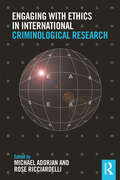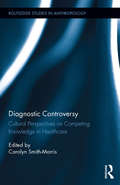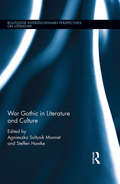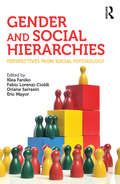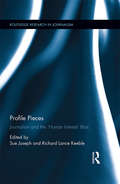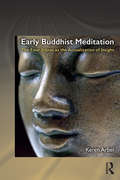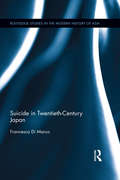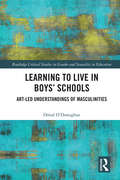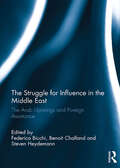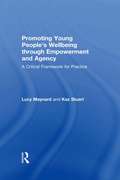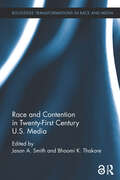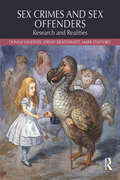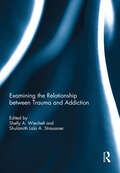- Table View
- List View
Engaging with Ethics in International Criminological Research
by Rose Ricciardelli Michael AdorjanDespite a voluminous literature detailing the procedures of research ethics boards and institutional ethical review processes, there are few texts that explore the realpolitik of conducting criminal research in practice. This book explores the unique lived experiences of scholars engaging with ethics during their criminological research, and focuses on the ethical dilemmas that researchers encounter both in the field and while writing up results for publication. Who benefits from criminological research? What are the roles and impacts of ethics review boards? How do methodological and theoretical decisions factor in to questions of ethical conduct and research ethics governance? This book is divided into four parts: Part I, Institutional arrangements and positionality, explores the ongoing and expanding process of ethics protocol and procedures, principles of confidentiality, and the positionality of the researcher. Part II, Trust and research with vulnerable populations, examines the complexity of work involving prisoners, indigenous peoples and victims of extreme violence, power dynamics between researchers and participants, and the challenges of informed consent. Part III, Research on and with police, reflects on the importance of transparent relations with police, best practices, and the consequences of undertaking research in authoritarian contexts. Part IV, Emerging areas, scrutinizes the ethics of carceral tours and suggests possible alternatives, and offers one of the first sociological and criminological examinations of dark net cryptomarkets. Drawing upon the experiences of international experts, this book aims to provoke further reflection on and discussion of ethics in practice. This book is ideal for students undertaking courses on research methods in criminology, as well as a key resource for criminology researchers around the world.
Diagnostic Controversy: Cultural Perspectives on Competing Knowledge in Healthcare (Routledge Studies in Anthropology #25)
by Carolyn Smith-MorrisThis collection is dedicated to the diagnostic moment and its unrivaled influence on encompassment and exclusion in health care. Diagnosis is seen as both an expression and a vehicle of biomedical hegemony, yet it is also a necessary and speculative tool for the identification of and response to suffering in any healing system. Social scientific studies of medicalization and the production of medical knowledge have revealed tremendous controversy within, and factitiousness at the outer parameters of, diagnosable conditions. Yet the ethnographically rich and theoretically complex history of such studies has not yet congealed into a coherent structural critique of the process and broader implications of diagnosis. This volume meets that challenge, directing attention to three distinctive realms of diagnostic conflict: in the role of diagnosis to grant access to care, in processes of medicalization and resistance, and in the transforming and transformative position of diagnosis for 21st-century global health. Smith-Morris’s framework repositions diagnosis as central to critical global health inquiry. The collected authors question specific diagnoses (e.g., Lyme disease, Parkinson's, andropause, psychosis) as well as the structural and epistemological factors behind a disease’s naming and experience.
Diagnostic Controversy: Cultural Perspectives on Competing Knowledge in Healthcare (Routledge Studies in Anthropology)
by Carolyn Smith-MorrisThis collection is dedicated to the diagnostic moment and its unrivaled influence on encompassment and exclusion in health care. Diagnosis is seen as both an expression and a vehicle of biomedical hegemony, yet it is also a necessary and speculative tool for the identification of and response to suffering in any healing system. Social scientific studies of medicalization and the production of medical knowledge have revealed tremendous controversy within, and factitiousness at the outer parameters of, diagnosable conditions. Yet the ethnographically rich and theoretically complex history of such studies has not yet congealed into a coherent structural critique of the process and broader implications of diagnosis. This volume meets that challenge, directing attention to three distinctive realms of diagnostic conflict: in the role of diagnosis to grant access to care, in processes of medicalization and resistance, and in the transforming and transformative position of diagnosis for 21st-century global health. Smith-Morris’s framework repositions diagnosis as central to critical global health inquiry. The collected authors question specific diagnoses (e.g., Lyme disease, Parkinson's, andropause, psychosis) as well as the structural and epistemological factors behind a disease’s naming and experience.
War Gothic in Literature and Culture (Routledge Interdisciplinary Perspectives on Literature)
by Agnieszka Soltysik Monnet Steffen HantkeIn the context of the current explosion of interest in Gothic literature and popular culture, this interdisciplinary collection of essays explores for the first time the rich and long-standing relationship between war and the Gothic. Critics have described the global Seven Year’s War as the "crucible" from which the Gothic genre emerged in the eighteenth century. Since then, the Gothic has been a privileged mode for representing violence and extreme emotions and situations. Covering the period from the American Civil War to the War on Terror, this collection examines how the Gothic has provided writers an indispensable toolbox for narrating, critiquing, and representing real and fictional wars. The book also sheds light on the overlap and complicity between Gothic aesthetics and certain aspects of military experience, including the bodily violation and mental dissolution of combat, the dehumanization of "others," psychic numbing, masculinity in crisis, and the subjective experience of trauma and memory. Engaging with popular forms such as young adult literature, gaming, and comic books, as well as literature, film, and visual art, War Gothic provides an important and timely overview of war-themed Gothic art and narrative by respected experts in the field of Gothic Studies. This book makes important contributions to the fields of Gothic Literature, War Literature, Popular Culture, American Studies, and Film, Television & Media.
War Gothic in Literature and Culture (Routledge Interdisciplinary Perspectives on Literature)
by Agnieszka Soltysik Monnet Steffen HantkeIn the context of the current explosion of interest in Gothic literature and popular culture, this interdisciplinary collection of essays explores for the first time the rich and long-standing relationship between war and the Gothic. Critics have described the global Seven Year’s War as the "crucible" from which the Gothic genre emerged in the eighteenth century. Since then, the Gothic has been a privileged mode for representing violence and extreme emotions and situations. Covering the period from the American Civil War to the War on Terror, this collection examines how the Gothic has provided writers an indispensable toolbox for narrating, critiquing, and representing real and fictional wars. The book also sheds light on the overlap and complicity between Gothic aesthetics and certain aspects of military experience, including the bodily violation and mental dissolution of combat, the dehumanization of "others," psychic numbing, masculinity in crisis, and the subjective experience of trauma and memory. Engaging with popular forms such as young adult literature, gaming, and comic books, as well as literature, film, and visual art, War Gothic provides an important and timely overview of war-themed Gothic art and narrative by respected experts in the field of Gothic Studies. This book makes important contributions to the fields of Gothic Literature, War Literature, Popular Culture, American Studies, and Film, Television & Media.
Gender and Social Hierarchies: Perspectives from social psychology
by Eric Mayor Klea Faniko Fabio Lorenzi-Cioldi Oriane SarrasinGender and Social Hierarchies offers a fresh and coherent picture of applied research from within social psychology on the intricate relationship between gender and social status. It comprises a collection of innovative approaches which seek to understand the pervasiveness of status asymmetry between gender categories. Drawing upon recent theoretical advances in gender psychology, the book provides tools for developing practical and political recommendations to address and resolve status inequality today. Each chapter examines a different aspect of the impact that gender-based social hierarchies have on people’s lives. Part One explores the consequences of gender stereotypes in school, higher education, and in professional settings. The struggles faced by women in the workplace are discussed in Part Two, featuring topics such as work-life balance, the ‘glass cliff’, and the lack of support for affirmative action. Part Three is devoted to the antecedents and consequences of gender-based forms of prejudice, such as discrimination against gay men, and against women within cultural minorities. The book concludes with some practical suggestions for working towards lasting and beneficial change. Gender and Social Hierarchies will appeal to scholars and students across the social sciences and offers important insights to practitioners and policy-makers.
Gender and Social Hierarchies: Perspectives from social psychology
by Eric Mayor Klea Faniko Fabio Lorenzi-Cioldi Oriane SarrasinGender and Social Hierarchies offers a fresh and coherent picture of applied research from within social psychology on the intricate relationship between gender and social status. It comprises a collection of innovative approaches which seek to understand the pervasiveness of status asymmetry between gender categories. Drawing upon recent theoretical advances in gender psychology, the book provides tools for developing practical and political recommendations to address and resolve status inequality today. Each chapter examines a different aspect of the impact that gender-based social hierarchies have on people’s lives. Part One explores the consequences of gender stereotypes in school, higher education, and in professional settings. The struggles faced by women in the workplace are discussed in Part Two, featuring topics such as work-life balance, the ‘glass cliff’, and the lack of support for affirmative action. Part Three is devoted to the antecedents and consequences of gender-based forms of prejudice, such as discrimination against gay men, and against women within cultural minorities. The book concludes with some practical suggestions for working towards lasting and beneficial change. Gender and Social Hierarchies will appeal to scholars and students across the social sciences and offers important insights to practitioners and policy-makers.
Profile Pieces: Journalism and the 'Human Interest' Bias (Routledge Research in Journalism)
by Sue Joseph Richard Lance KeebleThis book examines the history, theory and journalistic practice of profile writing. Profiles, and the practice of writing them, are of increasing interest to scholars of journalism because conflicts between the interviewer and the subject exemplify the changing nature of journalism itself. While the subject, often through the medium of their press representative, struggles to retain control of the interview space, the journalist seeks to subvert it. This interesting and multi-layered interaction, however, has rarely been subject to critical scrutiny, partly because profiles have traditionally been regarded as public relations exercises or as ‘soft’ journalism. However, chapters in this volume reveal not only that profiling has, historically, taken many different forms, but that the idea of the interview as a contested space has applications beyond the subject of celebrated individuals. The volume looks at the profile’s historical beginnings, at the contemporary manufacture of celebrity versus the ‘ordinary’, at profiling communities, countries and movements, at profiling the destitute, at sporting personalities and finally at profiling and trauma.
Profile Pieces: Journalism and the 'Human Interest' Bias (Routledge Research in Journalism)
by Sue Joseph Richard Lance KeebleThis book examines the history, theory and journalistic practice of profile writing. Profiles, and the practice of writing them, are of increasing interest to scholars of journalism because conflicts between the interviewer and the subject exemplify the changing nature of journalism itself. While the subject, often through the medium of their press representative, struggles to retain control of the interview space, the journalist seeks to subvert it. This interesting and multi-layered interaction, however, has rarely been subject to critical scrutiny, partly because profiles have traditionally been regarded as public relations exercises or as ‘soft’ journalism. However, chapters in this volume reveal not only that profiling has, historically, taken many different forms, but that the idea of the interview as a contested space has applications beyond the subject of celebrated individuals. The volume looks at the profile’s historical beginnings, at the contemporary manufacture of celebrity versus the ‘ordinary’, at profiling communities, countries and movements, at profiling the destitute, at sporting personalities and finally at profiling and trauma.
Early Buddhist Meditation: The Four Jhanas as the Actualization of Insight (Routledge Critical Studies in Buddhism)
by Keren ArbelThis book offers a new interpretation of the relationship between 'insight practice' (satipatthana) and the attainment of the four jhànas (i.e., right samàdhi), a key problem in the study of Buddhist meditation. The author challenges the traditional Buddhist understanding of the four jhànas as states of absorption, and shows how these states are the actualization and embodiment of insight (vipassanà). It proposes that the four jhànas and what we call 'vipassanà' are integral dimensions of a single process that leads to awakening. Current literature on the phenomenology of the four jhànas and their relationship with the 'practice of insight' has mostly repeated traditional Theravàda interpretations. No one to date has offered a comprehensive analysis of the fourfold jhàna model independently from traditional interpretations. This book offers such an analysis. It presents a model which speaks in the Nikàyas' distinct voice. It demonstrates that the distinction between the 'practice of serenity' (samatha-bhàvanà) and the 'practice of insight' (vipassanà-bhàvanà) – a fundamental distinction in Buddhist meditation theory – is not applicable to early Buddhist understanding of the meditative path. It seeks to show that the common interpretation of the jhànas as 'altered states of consciousness', absorptions that do not reveal anything about the nature of phenomena, is incompatible with the teachings of the Pàli Nikàyas. By carefully analyzing the descriptions of the four jhànas in the early Buddhist texts in Pàli, their contexts, associations and meanings within the conceptual framework of early Buddhism, the relationship between this central element in the Buddhist path and 'insight meditation' becomes revealed in all its power. Early Buddhist Meditation will be of interest to scholars of Buddhist studies, Asian philosophies and religions, as well as Buddhist practitioners with a serious interest in the process of insight meditation.
Early Buddhist Meditation: The Four Jhanas as the Actualization of Insight (Routledge Critical Studies in Buddhism)
by Keren ArbelThis book offers a new interpretation of the relationship between 'insight practice' (satipatthana) and the attainment of the four jhànas (i.e., right samàdhi), a key problem in the study of Buddhist meditation. The author challenges the traditional Buddhist understanding of the four jhànas as states of absorption, and shows how these states are the actualization and embodiment of insight (vipassanà). It proposes that the four jhànas and what we call 'vipassanà' are integral dimensions of a single process that leads to awakening. Current literature on the phenomenology of the four jhànas and their relationship with the 'practice of insight' has mostly repeated traditional Theravàda interpretations. No one to date has offered a comprehensive analysis of the fourfold jhàna model independently from traditional interpretations. This book offers such an analysis. It presents a model which speaks in the Nikàyas' distinct voice. It demonstrates that the distinction between the 'practice of serenity' (samatha-bhàvanà) and the 'practice of insight' (vipassanà-bhàvanà) – a fundamental distinction in Buddhist meditation theory – is not applicable to early Buddhist understanding of the meditative path. It seeks to show that the common interpretation of the jhànas as 'altered states of consciousness', absorptions that do not reveal anything about the nature of phenomena, is incompatible with the teachings of the Pàli Nikàyas. By carefully analyzing the descriptions of the four jhànas in the early Buddhist texts in Pàli, their contexts, associations and meanings within the conceptual framework of early Buddhism, the relationship between this central element in the Buddhist path and 'insight meditation' becomes revealed in all its power. Early Buddhist Meditation will be of interest to scholars of Buddhist studies, Asian philosophies and religions, as well as Buddhist practitioners with a serious interest in the process of insight meditation.
Suicide in Twentieth-Century Japan (Routledge Studies in the Modern History of Asia)
by Francesca Di MarcoJapan’s suicide phenomenon has fascinated both the media and academics, although many questions and paradoxes embedded in the debate on suicide have remained unaddressed in the existing literature, including the assumption that Japan is a "Suicide Nation". This tendency causes common misconceptions about the suicide phenomenon and its features. Aiming to redress the situation, this book explores how the idea of suicide in Japan was shaped, reinterpreted and reinvented from the 1900s to the 1980s. Providing a timely contribution to the underexplored history of suicide, it also adds to the current heated debates on the contemporary way we organize our thoughts on life and death, health and wealth, on the value of the individual, and on gender. The book explores the genealogy and development of modern suicide in Japan by examining the ways in which beliefs about the nation’s character, historical views of suicide, and the cultural legitimation of voluntary death acted to influence even the scientific conceptualization of suicide in Japan. It thus unveils the way in which the language on suicide was transformed throughout the century according to the fluctuating relationship between suicide and the discourse on national identity, and pathological and cultural narratives. In doing so, it proposes a new path to understanding the norms and mechanisms of the process of the conceptualization of suicide itself. Filling in a critical gap in three particular fields of historical study: the history of suicide, the history of death, and the cultural history of twentieth century Japan, it will be of great interest to students and scholars of Japanese Studies and Japanese History.
Suicide in Twentieth-Century Japan (Routledge Studies in the Modern History of Asia)
by Francesca Di MarcoJapan’s suicide phenomenon has fascinated both the media and academics, although many questions and paradoxes embedded in the debate on suicide have remained unaddressed in the existing literature, including the assumption that Japan is a "Suicide Nation". This tendency causes common misconceptions about the suicide phenomenon and its features. Aiming to redress the situation, this book explores how the idea of suicide in Japan was shaped, reinterpreted and reinvented from the 1900s to the 1980s. Providing a timely contribution to the underexplored history of suicide, it also adds to the current heated debates on the contemporary way we organize our thoughts on life and death, health and wealth, on the value of the individual, and on gender. The book explores the genealogy and development of modern suicide in Japan by examining the ways in which beliefs about the nation’s character, historical views of suicide, and the cultural legitimation of voluntary death acted to influence even the scientific conceptualization of suicide in Japan. It thus unveils the way in which the language on suicide was transformed throughout the century according to the fluctuating relationship between suicide and the discourse on national identity, and pathological and cultural narratives. In doing so, it proposes a new path to understanding the norms and mechanisms of the process of the conceptualization of suicide itself. Filling in a critical gap in three particular fields of historical study: the history of suicide, the history of death, and the cultural history of twentieth century Japan, it will be of great interest to students and scholars of Japanese Studies and Japanese History.
Learning to Live in Boys’ Schools: Art-led Understandings of Masculinities (Routledge Critical Studies in Gender and Sexuality in Education)
by Donal O'DonoghueThis book is about boys’ experiences of being educated in independent single-sex schools in Canada. These experiences, which are oftentimes attributed to particular places and moments at school, reveal ways in which school places are both "companionable" and "influential" in how boys become available to themselves and others as they pursue the possibility of becoming somebody. Curious about how masculinities show up in places at school and studying the sorts of gendered subjectivities that such places invite, entice, support and deny, the book extends beyond traditional ways of thinking and writing about the production of masculinities in education by introducing a different set of conceptual orientations and inquiry practices, including post-masculinities, weak theory, and art-led research and thought practices.
Learning to Live in Boys’ Schools: Art-led Understandings of Masculinities (Routledge Critical Studies in Gender and Sexuality in Education)
by Donal O'DonoghueThis book is about boys’ experiences of being educated in independent single-sex schools in Canada. These experiences, which are oftentimes attributed to particular places and moments at school, reveal ways in which school places are both "companionable" and "influential" in how boys become available to themselves and others as they pursue the possibility of becoming somebody. Curious about how masculinities show up in places at school and studying the sorts of gendered subjectivities that such places invite, entice, support and deny, the book extends beyond traditional ways of thinking and writing about the production of masculinities in education by introducing a different set of conceptual orientations and inquiry practices, including post-masculinities, weak theory, and art-led research and thought practices.
The Struggle for Influence in the Middle East: The Arab Uprisings and Foreign Assistance (Routledge Studies in Mediterranean Politics)
by Federica Bicchi, Benoit Challand and Steven HeydemannThis collection of research papers explores the impact of the Arab uprisings on the politics and political economy of foreign aid provision in the MENA region. Contributions focus on the foreign assistance policies and strategies of key donors (United States, Europe, Gulf countries and Turkey), and on the relationship between donors and recipients of foreign aid in a select set of MENA cases (Tunisia, Egypt, Palestine and to a lesser extent Morocco). Despite widespread rhetoric among lead donors pledging to support the transformational potential of the Arab uprisings, the contributions find a more complex pattern in foreign aid provision since 2011. Among Arab donors, who have played a significant role as providers of aid to states most affected by mass protests, trends in foreign assistance reflect the competing priorities of donors, and their willingness to politicize aid provision in pursuit of their strategic interests. Among Western donors, authors find a high degree of continuity. Chapters that focus on Western donors seek to account for continuity on the part of Western governments and the EU at a moment of profound transformational potential. Two factors, bureaucratization and securitization, capture most of the explanations provided, which take into account a variety of local dimensions as well. Contributions also discuss the changing assistance environment, namely the globalization of foreign assistance, the complex bureaucratic arrangements presiding over the delivery of European and US aid, and the role of regional and international non-democracies in the provision of foreign assistance.This book was published as a special issue of Mediterranean Politics.
The Struggle for Influence in the Middle East: The Arab Uprisings and Foreign Assistance (Routledge Studies in Mediterranean Politics)
by Federica Bicchi Benoit Challand Steven HeydermannThis collection of research papers explores the impact of the Arab uprisings on the politics and political economy of foreign aid provision in the MENA region. Contributions focus on the foreign assistance policies and strategies of key donors (United States, Europe, Gulf countries and Turkey), and on the relationship between donors and recipients of foreign aid in a select set of MENA cases (Tunisia, Egypt, Palestine and to a lesser extent Morocco). Despite widespread rhetoric among lead donors pledging to support the transformational potential of the Arab uprisings, the contributions find a more complex pattern in foreign aid provision since 2011. Among Arab donors, who have played a significant role as providers of aid to states most affected by mass protests, trends in foreign assistance reflect the competing priorities of donors, and their willingness to politicize aid provision in pursuit of their strategic interests. Among Western donors, authors find a high degree of continuity. Chapters that focus on Western donors seek to account for continuity on the part of Western governments and the EU at a moment of profound transformational potential. Two factors, bureaucratization and securitization, capture most of the explanations provided, which take into account a variety of local dimensions as well. Contributions also discuss the changing assistance environment, namely the globalization of foreign assistance, the complex bureaucratic arrangements presiding over the delivery of European and US aid, and the role of regional and international non-democracies in the provision of foreign assistance.This book was published as a special issue of Mediterranean Politics.
Promoting Young People's Wellbeing through Empowerment and Agency: A Critical Framework for Practice
by Lucy Maynard Karen StuartThe terms ‘wellbeing’, ‘empowerment’ and ‘agency’ are common parlance in policy and practice with children, young people and families (CYPF), yet are often misused or not fully understood. Further, there is a disconnect between these abstract concepts and tangible practice with CYPF. This book bridges the theory-practice divide, offering a clear and definitive guide to concepts and practical ways to develop CYPF wellbeing. It examines the concept of wellbeing and its intrinsic relationship to social justice both theoretically and through case study material, and locates these practices within critical pedagogy. The book highlights a range of practice with CYPF of various ages, in formal and non-formal learning situations, engaged in a range of different programmes including learning, reduction from offending, social action and tackling targeted needs. Each chapter highlights relevant policy, research and practice examples to ensure that the book is relevant to a variety of readers. This book will benefit students and practitioners who work with young people to realise wellbeing and to embed critical pedagogy in their practice. It also provides a frame of reference to critically engage in policy analysis and is essential reading for social workers, teachers, police support officers and anyone working to support CYPF to become empowered.
Promoting Young People's Wellbeing through Empowerment and Agency: A Critical Framework for Practice
by Lucy Maynard Karen StuartThe terms ‘wellbeing’, ‘empowerment’ and ‘agency’ are common parlance in policy and practice with children, young people and families (CYPF), yet are often misused or not fully understood. Further, there is a disconnect between these abstract concepts and tangible practice with CYPF. This book bridges the theory-practice divide, offering a clear and definitive guide to concepts and practical ways to develop CYPF wellbeing. It examines the concept of wellbeing and its intrinsic relationship to social justice both theoretically and through case study material, and locates these practices within critical pedagogy. The book highlights a range of practice with CYPF of various ages, in formal and non-formal learning situations, engaged in a range of different programmes including learning, reduction from offending, social action and tackling targeted needs. Each chapter highlights relevant policy, research and practice examples to ensure that the book is relevant to a variety of readers. This book will benefit students and practitioners who work with young people to realise wellbeing and to embed critical pedagogy in their practice. It also provides a frame of reference to critically engage in policy analysis and is essential reading for social workers, teachers, police support officers and anyone working to support CYPF to become empowered.
Race and Contention in Twenty-First Century U.S. Media (Routledge Transformations in Race and Media)
by Jason A. Smith Bhoomi K. ThakoreThis volume explores and clarifies the complex intersection of race and media in the contemporary United States. Due to the changing dynamics of how racial politics are played out in the contemporary US (as seen with debates of the "post-racial" society), as well as the changing dynamics of the media itself ("new vs. old" media debates), an interrogation of the role of the media and its various institutions within this area of social inquiry is necessary. Contributors contend that race in the United States is dynamic, connected to social, economic, and political structures which are continually altering themselves. The book seeks to highlight the contested space that the media provides for changing dimensions of race, examining the ways that various representations can both hinder or promote positive racial views, considering media in relation to other institutions, and moving beyond thinking of media as a passive and singular institution.
Race and Contention in Twenty-First Century U.S. Media (Routledge Transformations in Race and Media)
by Jason A. Smith Bhoomi K. ThakoreThis volume explores and clarifies the complex intersection of race and media in the contemporary United States. Due to the changing dynamics of how racial politics are played out in the contemporary US (as seen with debates of the "post-racial" society), as well as the changing dynamics of the media itself ("new vs. old" media debates), an interrogation of the role of the media and its various institutions within this area of social inquiry is necessary. Contributors contend that race in the United States is dynamic, connected to social, economic, and political structures which are continually altering themselves. The book seeks to highlight the contested space that the media provides for changing dimensions of race, examining the ways that various representations can both hinder or promote positive racial views, considering media in relation to other institutions, and moving beyond thinking of media as a passive and singular institution.
Sex Crimes and Sex Offenders: Research and Realities
by Donna Vandiver Jeremy Braithwaite Mark StaffordSex Crimes and Sex Offenders: Research and Realities provides an overview of social scientific theory and research on sex crimes and sex offenders. Most other books on the market are focused on a single issue—such as treatment, rape, pedophilia, theory, etc. This book is unique in that it covers the most current theory and research along with individual cases of sex crimes (e.g., Kobe Bryant, Jerry Sandusky, and other case studies), effectively linking theory and research with the realities of sex crimes and sex offenders as well as their victims. Vandiver, Braithwaite, and Stafford are careful to dispel myths and to focus on the heterogeneity of sex crimes and sex offenders, and not on any one issue or population or theory. Instead, they weave a framework using a full range of theoretical concepts and research data to integrate their discussions of crimes, offenders, victims, treatments, and policy implications. The result is a valuable resource for students and early-stage researchers investigating sex crimes or offenders.
Sex Crimes and Sex Offenders: Research and Realities
by Donna Vandiver Jeremy Braithwaite Mark StaffordSex Crimes and Sex Offenders: Research and Realities provides an overview of social scientific theory and research on sex crimes and sex offenders. Most other books on the market are focused on a single issue—such as treatment, rape, pedophilia, theory, etc. This book is unique in that it covers the most current theory and research along with individual cases of sex crimes (e.g., Kobe Bryant, Jerry Sandusky, and other case studies), effectively linking theory and research with the realities of sex crimes and sex offenders as well as their victims. Vandiver, Braithwaite, and Stafford are careful to dispel myths and to focus on the heterogeneity of sex crimes and sex offenders, and not on any one issue or population or theory. Instead, they weave a framework using a full range of theoretical concepts and research data to integrate their discussions of crimes, offenders, victims, treatments, and policy implications. The result is a valuable resource for students and early-stage researchers investigating sex crimes or offenders.
Examining the Relationship between Trauma and Addiction
by Shelly A. Wiechelt and Shulamith Lala A. StraussnerTrauma, trauma-related disorders, substance use, and addictive disorders often co-occur, and frequently play a role in the problems and issues that social workers contend with in their practice with individuals, families, and communities. Research shows that there is a relationship between trauma-related symptoms and problematic use of substances and other addictive behaviors. Individuals who experience these co-occurring problems have better outcomes when their issues are addressed with integrated treatment approaches. Trauma-informed care and trauma-specific treatment are therefore important components of effective social work interventions.This book examines various types of trauma, such as intergenerational trauma, adverse childhood events, childhood sexual abuse, and minority stress, amongst various populations and settings, including Native Americans, homeless youth, drug court participants, and LGB adolescents. It also explores the challenges in delivering trauma services in outpatient addiction treatment settings. Furthermore, it provides practical information on how to implement trauma-informed approaches in addiction treatment, and offers insights into the experience of a trauma survivor who is also recovering from a substance use disorder. This book was originally published as a special issue of the Journal of Social Work Practice in the Addictions.
Examining the Relationship between Trauma and Addiction
by Shelly Wiechelt Shulamith Lala A. StraussnerTrauma, trauma-related disorders, substance use, and addictive disorders often co-occur, and frequently play a role in the problems and issues that social workers contend with in their practice with individuals, families, and communities. Research shows that there is a relationship between trauma-related symptoms and problematic use of substances and other addictive behaviors. Individuals who experience these co-occurring problems have better outcomes when their issues are addressed with integrated treatment approaches. Trauma-informed care and trauma-specific treatment are therefore important components of effective social work interventions.This book examines various types of trauma, such as intergenerational trauma, adverse childhood events, childhood sexual abuse, and minority stress, amongst various populations and settings, including Native Americans, homeless youth, drug court participants, and LGB adolescents. It also explores the challenges in delivering trauma services in outpatient addiction treatment settings. Furthermore, it provides practical information on how to implement trauma-informed approaches in addiction treatment, and offers insights into the experience of a trauma survivor who is also recovering from a substance use disorder. This book was originally published as a special issue of the Journal of Social Work Practice in the Addictions.
